A brash young U.S. Army officer lived up to his hair-raising heritage
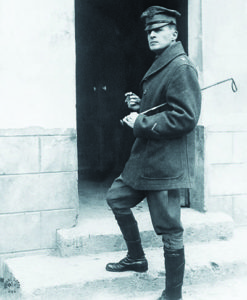
DOUGLAS MACARTHUR was a paradox. He received 13 awards for bravery, including the Medal of Honor. Perhaps the most gifted battlefield soldier America ever produced, he orchestrated remarkable victories in France, New Guinea, the Philippines, and Korea while economizing on casualties. As viceroy of Japan, he bestowed forgiveness and introduced Dai Nippon to civil liberties and equal rights for women. Yet MacArthur’s heroics, displays of principle and magnetic aura were inevitably offset by pettiness, paranoia, and appalling vindictiveness. In short, wrote biographer William Manchester, “No more baffling, exasperating soldier ever wore a uniform.”
MacArthur first achieved fame as a boy brigadier in the Great War. Doughboys called him the “the fighting Dude,” and he seemed to enjoy a charmed life. Once, near Saint-Mihiel, he and a young tank officer were standing close together as German rounds crumped closer and closer. “Don’t worry, Major,” Douglas MacArthur said as George Patton flinched. “You never hear the one that gets you.”
As the next war was engulfing the United States and Japanese pilots were raiding Corregidor, MacArthur, walnut cane under one arm and a crushed, weathered campaign hat atop his head, stood by a hedge, coolly counting enemy fighters and bombers. “Look what they have done to the garden,” he remarked with patrician aplomb as water splashed and clods of earth erupted around him. Some Corregidor veterans later vilified him as “Dugout Doug,” but MacArthur was never one to dodge shot and shell. Still, even his valor could generate controversy. Perhaps the earliest example came in 1914 when, during a standoff between the United States and Mexico, MacArthur led a covert reconnaissance deep into enemy territory outside Veracruz.
It’s fair to say that the 1903 West Point graduate inherited his brass. In November 1863 at Chattanooga, Tennessee, in what Manchester termed an “act of magnificent insubordination,” young MacArthur’s father, Arthur Jr., a stripling Union Army captain, screamed “On, Wisconsin!” as he led his 24th Regiment volunteers triumphantly up Missionary Ridge. A quarter-century later, after spending many years at dirt-choked frontier duty, Arthur would receive a Medal of Honor for his Missionary Ridge feat. String-pulling by his father, a well-connected Washington judge, boosted his visibility and finally propelled him up the ranks. Missionary Ridge was one bookend to Arthur’s career. The other was his role in the Filipino insurrection of 1899-1902. First as an Army brigadier and then as the archipelago’s military governor, Arthur MacArthur managed to outfight and outfox guerrilla leader Emilio Aguinaldo’s insurrectos.
Later, however, Arthur crossed William Howard Taft, President William McKinley’s political emissary to the Philippines. When Taft replaced him in Manila, Arthur MacArthur came stateside to higher rank and shrinking relevance until, at the 24th Wisconsin’s 1912 reunion, he collapsed and died, leaving behind wife Mary and sons Arthur III, a navy officer stationed aboard a destroyer, and Douglas, an army captain at Fort Leavenworth.
Two years later, in April 1914, Captain Douglas MacArthur, now serving on the army General Staff, was sidelined with tonsillitis and living with his mother at the Hadleigh apartment house at 16th and U streets NW in Washington D.C. Reading an order in the form of a telegram from Chief of Staff Major General Leonard Wood, “Pinky” MacArthur rousted her 34-year-old bachelor son and got him into uniform. She had known Wood since Arthur’s frontier fort days; indeed, her husband’s passing had pulled Douglas into Woods’s orbit.
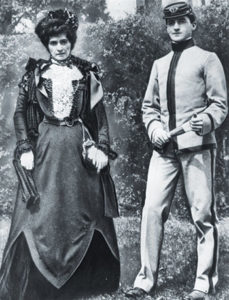
Pinky MacArthur believed in her son’s high destiny, but not everyone agreed. Douglas graduated first in his class at West Point and performed creditably as a shavetail engineering officer in the post-insurrection Philippines, but on subsequent assignments his performance stirred doubt. He was, wrote Manchester, “already haughty, dashing, fearless, and consumed by the ambitions bequeathed him by his parents.”
In November 1903, during his Philippines tour, two Filipino bandits ambushed Second Lieutenant MacArthur. A shot ripped the peak of his campaign hat, but MacArthur coolly leveled his revolver to dispatch both attackers. “Begging thu Loo’tenant’s paddon,” said a sergeant accompanying him, “but all the rest of the Loo’tenant’s life is pure velvut.”
MacArthur’s hauteur showed in his disinterest in routine assignments and his questioning of authority. In 1905, a superior wondered “with what enthusiasm he [MacArthur] would carry out work…if objection [by MacArthur] came in the way.” Two years later, the commandant of the Army’s Engineer School of Application rated MacArthur’s work “not equal to that of most of the other student officers.” The worst came in a 1908 efficiency report. “Lieutenant MacArthur’s duties,” wrote Major William V. Judson, “were not performed in a satisfactory manner.”
The young officer partially rehabilitated himself. Reversing the reputation of Fort Leavenworth’s lowest-rated infantry company, MacArthur rose to adjutant of his battalion and, in 1911, to captain. Still, he had achieved no breakthrough to match Dad’s on Missionary Ridge.
MacArthur reached the State, War and Navy Building—today’s Executive Office Building—on April 23, 1914, to find Wood fresh from meeting Lindley Garrison, President Woodrow Wilson’s interventionist Secretary of War. Wood had begun his Army career as a civilian physician working on contract. Commissioned in the Medical Corps, he switched to the cavalry, during the Apache Wars garnering a Medal of Honor and in the Spanish-American War serving as overall commander of Teddy Roosevelt’s Rough Riders regiment. Upon Spain’s capitulation Wood became Cuba’s military governor. Appointed army chief of staff in 1910, Wood was a political soldier who shared TR’s notions about wielding U.S. power and Roosevelt’s conviction that America’s army should be prepared to fight anybody anywhere at any time.
Wood, Garrison, and Wilson were furious at a provocation by Mexican president Victoriano Huerta. The preceding February, Huerta, in league with American ambassador Henry Lane Wilson, had overthrown his predecessor and now was fighting off various insurrectionist factions.
Huerta had angered the Americans by insulting their flag at a tense time between the United States and Mexico. On April 9, U.S. Navy gunboat Dolphin had dispatched sailors in a whaleboat to buy gasoline at Tampico, an oil town on the Bay of Campeche off the Gulf of Mexico. Mexican soldiers arrested and jailed the nine Americans. Authorities quickly released the bluejackets, but U.S. naval forces commander Admiral Henry T. Mayo demanded of Huerta a formal apology and a 21-gun salute. Huerta issued the apology but declined to order the salute, even though prior to the incident Dolphin, at Mexico’s request, had rendered several such vollies.
Tensions worsened. Wilson contemplated sending Wood south on a punitive expedition. In his office, Wood told MacArthur he had thought of adding the captain to that expedition’s staff, but had decided instead to send MacArthur ahead to assess the situation.
“I can be off in an hour,” MacArthur assured Wood. After securing passage for MacArthur aboard battleship Nebraska, the general sent off his man with instructions specifying that MacArthur obtain “all possible information which would be of value.” Boarding Nebraska at New York City a day later, MacArthur soon sailed. He was en route when a brief, bloody clash erupted between the forces of the United States and Mexico. Tipped off that a German vessel bringing Huerta arms and ammunition was bound for Veracruz, Mexico’s main Gulf port 300 miles south of Tampico, Wilson bypassed Congress to order U.S. sailors and marines to seize Veracruz. The invasion succeeded, at a cost of 500 casualties on both sides. The U.S. Army’s 5th Brigade, with 7,000 troops, occupied Veracruz after an entry an American journalist portrayed as “hobnailed brogans [striking] the asphalt with the regularity of pile drivers.”
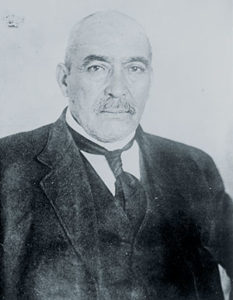
Captain MacArthur reached Veracruz May 1 and soon was at Brigadier General Frederick Funston’s 5th Brigade headquarters. MacArthur and his host presented a striking contrast. Funston, 15 years older, was carrying much more weight on his 5’5’’ frame than in his youth, and his red hair and Van Dyke had gone gray. A spare six-footer, MacArthur cut the more martial profile.
But Funston was a bona fide combat legend. After stints as a reporter and explorer, he entered military life in 1896 as a filibuster or mercenary, fighting for pay in Cuba’s revolt against Spain. In 22 battles, Funston twice sustained chest wounds and endured two crushed legs when a horse fell from under him. Captured and paroled by Spanish authorities, he returned stateside in January 1898 to acclaim and a colonelcy in the 20th Kansas Volunteers.
When the 20th deployed to the Philippines as part of Arthur MacArthur’s counterinsurgency campaign, Funston again stood out. In March 1901, Funston, masquerading as a POW and with excellent timing, penetrated insurgent territory and personally captured guerrilla leader Aguinaldo. The deed catapulted Funston to brigadier in the regular Army—a career arc of only five years. This was clear evidence to Douglas MacArthur of how, with America pursuing its “manifest destiny,” derring-do could accelerate a soldier’s career.
Now Funston faced a bind no valor of his could unknot. Funston’s 7,000-man brigade was chin-to-chin against Huerta’s 11,000. For all Wilson’s public boldness, the president had his bantam general on a short leash, explicitly ordering that Funston stay inside the lines. “If a disaster should result,” Funston confided to his diary, “I must not be held responsible.”
The Mexicans seemed ready to fight, so Funston badly needed to know his transport options. Veracruz was short on horses, mules, and trucks. The port had rail yards and plenty of freight cars but no locomotives—at least, none Funston could lay hands on. There might be engines inland but he could not risk penetrating Mexican lines to look for them.
MacArthur faced a delicate situation. He reported not to Funston but to Wood, who had pointedly told him to obtain all necessary information. Funston needed to know where there were locomotives. If that was not necessary information, what was? Washington was very far away. He would seize the moment.
Constant Cordier, a captain in one of Funston’s regiments and a Washington pal, pointed MacArthur to a Mexican rail engineer. The railroad man, in his cups, had told Cordier there might be locomotives in Alvarado, 42 miles southeast. MacArthur found the engineer in a rundown cantina, sobered him up and, using his smattering of Spanish, proposed a deal. If the Mexican led MacArthur to Alvarado, MacArthur—upon their successful return—would pay the engineer $150 in gold. The Mexican agreed and the two laid plans.
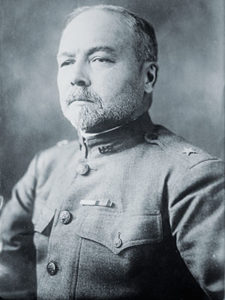
Two train lines ran out of Veracruz: broad-gauge rails bearing nearly 300 miles south from Veracruz to Tehuantepec near the Pacific coast, and a narrow-gauge line southeast to Alvarado. American forces held the narrow-gauge line only as far as Tejar, nine miles outside Veracruz. Four miles farther, at Paso del Toro, the Tehuantepec and Alvarado lines crossed. To avoid the Mexicans holding Tejar, MacArthur and the engineer agreed, they would obtain a handcar and travel by broad gauge from Veracruz to Paso del Toro. The engineer would have two railroad workers waiting at Pasa del Toro to transport them the final miles into Alvarado on a narrow-gauge handcar.
There is dispute about how MacArthur equipped himself for his foray. “He decided to take nothing except his .45 pistol, his dog tags and a small Bible,” Arthur Herman writes in a new biography. “He wasn’t even traveling in uniform, though that meant if he was caught, he could be shot as a spy.” Other accounts, including MacArthur’s after-action report to Wood, have him in uniform, but dress probably didn’t matter. At around the same time, a U.S. Army private, Samuel Parks, stole two horses and crossed into Mexican territory. The enemy summarily executed him. MacArthur was risking all as he set out at dusk under squally, overcast skies to reach his rendezvous.
After crossing on foot unseen through American lines, MacArthur found the Mexican engineer at a siding, waiting with the handcar. Over the man’s objections, MacArthur patted him down, confiscating a .38 and a dagger. MacArthur then allowed the engineer to frisk him, to telegraph that the Mexican would be getting his $150 in gold only after they returned—if they returned.
Their handcar, sometimes called a “pump trolley,” was powered by a seesaw-like “walking beam.” Rhythmically pushing down and pulling up on the beam, the two sped along the Tehuantepec line as far as the Jamapa River, where the rail bridge was down. On the bank, they found a small canoe in which they crossed the Jamapa. At the far shore, they stole two ponies and trotted them alongside the Tehuantepec line. Skirting Paso del Toro, the pair found the railroad workers with the promised narrow-gauge handcar awaiting on the Alvarado rails. MacArthur searched his new conspirators, finding no weapons. Hiding the stolen ponies, the four pumped toward Alvarado.
Small bridges and culverts dotted the line. At the first structure, the Mexicans stopped to check it, prompting MacArthur to draw his .45 as a prod. “After getting into the spirit of the thing,” MacArthur wrote in his account to Wood, “their conduct was most admirable.”
Still, MacArthur was taking no chances. At each town he tied himself to one man and sent the other two through on the handcar while he and his “companion” circled the village and rejoined the party on the far side. “This took time,” MacArthur admitted later, “but was the only way I could avoid detection.”
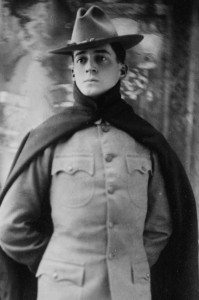
Making Alvarado shortly after 1 a.m., MacArthur almost immediately found what he sought: five railroad engines. Two were yard switch engines, “worthless for our purpose,” but three were “fine big road pullers,” he wrote later. Quickly inspecting the locomotives, MacArthur climbed aboard the handcar for the 42-mile run to Veracruz—and a host of troubles.
The pre-dawn return ride was uneventful as far as Salinas, where, as before, MacArthur and a tethered companion set out to edge around the coastal town. Five armed men confronted them—in MacArthur’s words, “one of the marauding bands that infest the country with brigandage as a trade.”
The American and his companion ran for it, outdistancing three pursuers but not the other two, who cornered them. Shots might alert Mexican soldiers and panic the men with the other handcar, but MacArthur had no choice. He stopped, aimed, and fired his .45 automatic. Both assailants went down.
On the handcar, now traveling through a blinding mist, the shaken quartet pushed on to Piedra, where 15 armed horsemen surrounded them. “We were among them before I realized it and were immediately the center of a melee,” MacArthur said later. The engineer stopped a slug with his shoulder. Three rounds passed through MacArthur’s clothes without striking flesh. Riders knocked him from the handcar. Regaining his feet, the captain fired, taking down four foes at close range. The others fled. After reloading his .45 and patching up the wounded man, MacArthur led his squad—bloodied, exhausted, and rattled—north “with all possible speed.”
Near Laguna, halfway to Paso del Toro, the men encountered three mounted pistoleros. A running gunfight ensued, with the handcar rolling hard and riders trying to keep up. Remarkably, the car, occupants laboring like human pistons, outdistanced two horsemen. But the third, “unusually well mounted” in MacArthur’s estimation, “overhauled and passed the car.” After taking another bullet through his shirt and having rounds twice ricochet inches away, MacArthur “felt obliged to bring him down.” The man fell—as did his mount, sprawling dead across the tracks ahead. It took all four men to drag the carcass and corpse out of their way.
Luck seemed to bend their way at Paso del Toro. Leaving their accomplices with the narrow-gauge handcar, MacArthur and the engineer retrieved the ponies and rode to the Jamapa. The canoe was as they had left it. They set to paddling but a snag overturned the boat. Fortunately, the river was shallow enough to keep them from drowning, but MacArthur needed what little remained of his waning strength to keep the wounded Mexican’s head above water as he hauled him ashore. It was after dawn when the men—soaked and disheveled, one wounded, the other in a shirt ventilated by four bullets—passed through the American lines at Veracruz. The adventure was over, but, typical of Douglas MacArthur, controversy was already brewing.
Had the U.S. gone to war with Victoriano Huerta, MacArthur’s exploit might have made headlines. “It is a mystery to me,” Cordier said after seeing MacArthur’s condition, “that any of the party escaped.” MacArthur relayed his information about the locomotives to Funston’s aide, who, perhaps because of the Parks incident, did not forward the hard-earned intelligence to his boss.
The American occupation of Veracruz settled, MacArthur biographer D. Clayton James writes, “into a quiet routine of administering municipal affairs, collecting customs revenues, and introducing public health and judicial reforms.” During Funston’s seven-month standoff with Huerta, MacArthur’s sally and Parks’s execution marked the occupation’s only “hostile acts.”
MacArthur was initially circumspect about his escapade. He mentioned it in passing in a May 7 dispatch to Washington. Leaving Veracruz on August 20, he arrived in Washington to find that Wood, now out of favor with the Wilson administration, had been replaced as Army chief of staff.
After the violence in Veracruz, the Navy Department showered sailors and marines with Medals of Honor. Lopsided naval profligacy—46 Navy and nine Marine awards, only one for an Army soldier—may have figured in the official army response to MacArthur’s daring recon run. The imbalance—the most valor awards for a U.S. battle before or since—likely was indicative of new Secretary of the Navy Josephius Daniel’s partisanship. But it also reflected intense house-to-house fighting by sailors and marines before Army troops ever reached the scene.
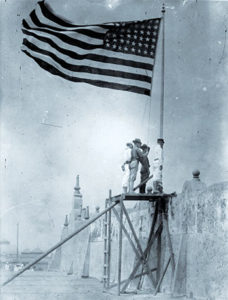
Two days before MacArthur left Veracruz, Constant Cordier wrote to Wood, “If any deed of daring merits the Medal of Honor surely MacArthur’s audacious undertaking is one.” Wood, now heading the Department of the East and with MacArthur’s report in hand, agreed, and recommended the captain receive a Medal of Honor. However, when Woods’s endorsement and documentation reached Funston, the case began wobbling. The old campaigner claimed that not until after returning from Veracruz did he know of the young officer’s venture. “I had not the slightest information regarding the reconnaissance made by Captain MacArthur,” Funston said.
The case for MacArthur’s receiving the medal fared little better with a review board. Two of three members, while confirming MacArthur’s “distinguished gallantry,” nonetheless questioned the “advisability” of awarding the Medal of Honor for a foray undertaken without the local commanding officer’s knowledge. The third man didn’t equivocate: the case for MacArthur lacked “incontestable proof” and there was nothing “clearly to distinguish him from the gallantry and intrepidity above his comrades.”
Even with that thumbs-down, the matter simmered. Still pulling strings, Wood managed to keep MacArthur’s candidacy alive, requesting clarification—whereupon Douglas MacArthur intervened on his own behalf. Excoriating the board for “rigid narrow-mindedness and lack of imagination,” he protested vehemently to army chief of staff Major General Hugh M. Scott.
MacArthur’s special pleading doubtless sealed his fate. On March 2, 1915, with MacArthur still assigned to the General Staff, the board confirmed an “adverse recommendation.” The roller coaster that was Douglas MacArthur’s career, after soaring on a foreign battlefield, bottomed out in Washington’s corridors of power.
His ride, however, was just beginning.✯
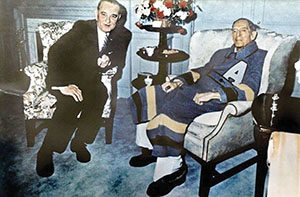
Fifty years after his Mexican adventure (p. 60), Douglas MacArthur was battling what would be his final illness at Walter Reed Medical Center in Washington, D.C. Shortly before noon on March 13, 1964, the frail former fighting man had a visitor: President Lyndon B. Johnson, bearing a bouquet of roses and chrysanthemums and on his lapel the Silver Star that MacArthur, as commander of Allied forces in the southwest Pacific, had awarded him for valor in 1942. LBJ had come out of kindness—and, ever the campaigner, in hopes of a photo opportunity. From his chair, MacArthur, wearing his West Point bathrobe and drawing on a lifetime in the military, performed one last service to his country. The old soldier, 84, beseeched the president not to commit ground troops in Vietnam—the same message he had given Johnson’s predecessor. In 1961, MacArthur told President John F. Kennedy that anyone wanting to put American forces into mainland Asia “should have his head examined.” Were the nation to send even a million men, MacArthur told JFK, “we would still find ourselves outnumbered on every side.” LBJ got his photo and went his way. On March 16, Defense Secretary Robert S. McNamara advised Johnson that the situation in South Vietnam “has unquestionably been growing worse;” the beleaguered republic needed more American support. Three weeks later MacArthur was dead. That August, at Johnson’s behest, Congress passed the Tonkin Gulf Resolution, giving the president broad powers to widen the conflict in Vietnam. —Joseph Connor
This story was originally published in the February 2017 issue of American History magazine. Subscribe here.





